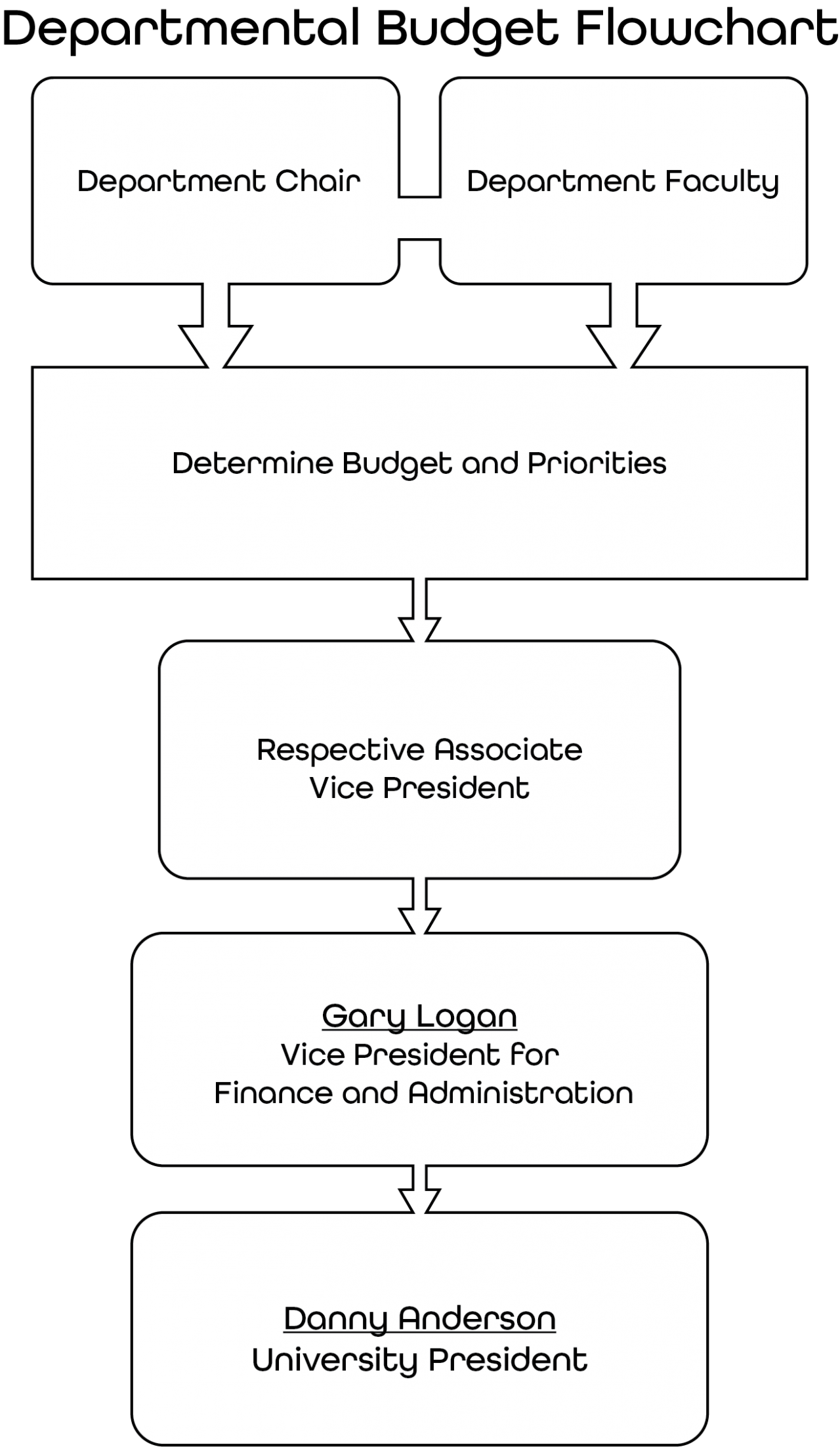Graphic by Quinn Butterfield
Departmental budgets endure multiple levels of discussion and rearrangement before receiving approval, and after all that, they rarely change.
There are two kinds of budget requests coming from departments — operating budget requests and capital equipment requests. Both go through the same process of beginning at the departmental level and ending with the approval of the executives.
The process begins in the fall within each department. Discussions occur between the chair or director of the department and the rest of the staff or faculty.
“They know best what the priorities should be for that department, whether they should spend more on travel, or more on reagents in a lab, or more on consulting, or whatever. We really do trust the chairs to come up with those priorities,” said David Ribble, biology professor and associate vice president for Academic Affairs: Budget and Research.
After the departments have determined their budget and priorities, their proposal is put through discussion with their vice president. For academic departments, their vice president is Ribble, who then reports to Deneese Jones, vice president for Academic Affairs. For Student Involvement and various other departments, the vice president is Sheryl Tynes, vice president for Student Life.
Once the chairs and directors of the departments have worked through their requests with their vice president, the requests go to Gary Logan, vice president for finance and administration.
“It doesn’t come to my department for decisions, it comes to mine to be structured in a way that when it goes to [president Danny] Anderson, everyone’s is the same structure. So we’re cleaning that up and getting it organized, and then we’re sending it to [Anderson],” Logan said.
Organizing means formatting and placing budget requests accurately in either the operating budget or capital equipment requests. After discussion between the vice presidents and the president, the final step is approval from Anderson and the Board of Trustees.
“There’s always more demand than there is money, so at that point, we’re really looking for ‘what are the essentials?’ The things that we must do to move the mission of the institution forward, to serve students and alumni, and then there’s some things that we would like to do, but they’re not essentials,” Logan said. “Budgeting, by and large, is a process where you’re trying to efficiently allocate resources to support the highest strategic needs of the institution.”
Capital equipment requests are large, one-time requests like a new lab or new carpeting. Operating budgets are the year-to-year funding departments need to keep their programs up and running, including things like office supplies and travel expenses. Trinity’s operating budgets are not a zero-base budget approach but instead a system that adjusts the previous year’s budgets only slightly.
“We’re not doing what’s called a zero-base budgeting approach, which means I get no money guaranteed to me every year, and I’ve got to build a case for whatever money I need every year. Trinity starts with the prior year funding and works off that, plus or minus off the margins of each department. If a department is overfunded for whatever reason, their vice president works with them to identify that and reallocates that money to higher needs someplace else,” Logan said.
Departmental budgets are funded by Trinity’s operating budget, which is made up primarily of student revenues and the endowment. Because of this limited amount of money and this system of budgeting, the operating budgets of departments across campus have remained fairly constant for years.
“Essentially, our departmental budgets are staying about the same,” Ribble said. “Trinity, in our efforts to continue to try to do better, is spending money on new projects. There’s always this struggle between what departments need and what the university identifies as an overall big thing.”
The university’s focus on the Trinity Tomorrow Strategic Plan has led to money being spent on new projects and new initiatives. Back in 2013, the plan called for the creation of the Center for Experiential Learning and Career Success, the Center for International Engagement and the Student Success Center. As of now, all of those centers have been created and funded.
“When those came online, those were funded and created and developed because they were identified as a priority out of the Strategic Plan,” said Jame Thompson, director of Student Involvement.
Consequently, academic chairs are constrained to work within their set budgets.
“It’s not a matter of prioritizing because it’s kind of set, those things that I have to have. It’s finding money for other things within our budget, trying to be creative within our budget to help fund new things,” said Andrew Hansen, chair of the human communication and theatre department.
Directors of departments face the same issue, but Thompson feels their programs remain consistent, so they’re not affected by a consistent budget.
“In some ways, the fact that we’ve had a static budget doesn’t negatively impact us in Student Involvement because our work is pretty consistent year-over-year. When we have new needs, I either go through the budget request process, or we’ll make a decision to reallocate internally,” Thompson said.
If departments want to increase their yearly operating budget, the reason would need to align with current university goals.
“If somebody wanted to purpose an increase, it would need to be consistent with the university’s priorities at the time. Right now, our priorities are retention, diversity and inclusion and digital transformation. Anything that’s related to that we’ll consider,” Ribble said.
Hansen explains that departments try and strategize around this.
“People use our Stieren Theatre for Trinity in Focus and outside groups, so we know that will be taken care of. People need microphones for those events, so we can put those as priorities because we’re pretty confident that the university will see those as important for them too, not just for us. We try to find those things that are important to the whole university and not just an individual program,” Hansen said.
Student Involvement also attempts to interweave their needs with those of the university.
“Part of the work we do in Student Involvement when it comes to budgeting is that we understand the role that we play across the institution and the context of what’s going on in other spaces on campus. What do we understand the other needs to be and where do our needs fit into that?” Thomson said.







